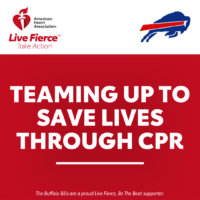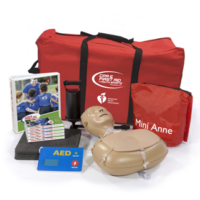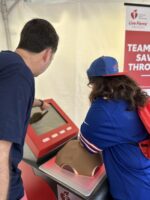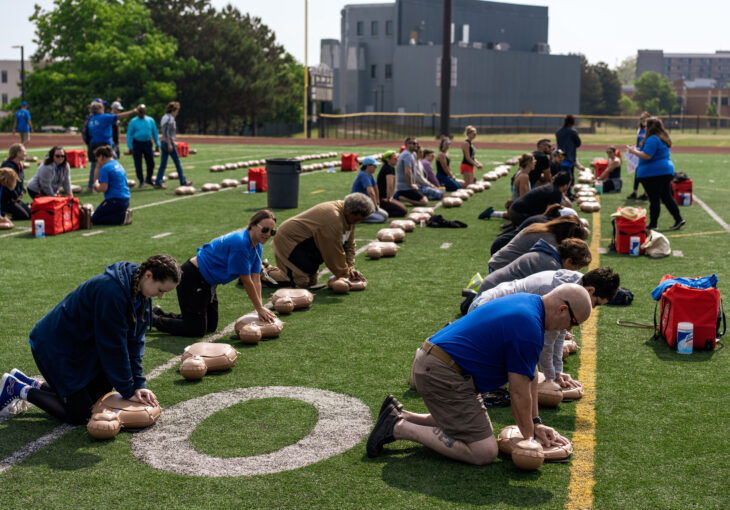A year ago, the world watched as CPR and AED use saved the life of Buffalo Bills safety Damar Hamlin. Today, that incident is still creating a ripple effect through Western New York and beyond.
“I think [Hamlin’s] incident was a tragedy that was kind of turned into a testimony and a triumph,” said Alik Matthews, RN, BSN, CPR Instructor with CPR 2 You in Buffalo and an American Heart Association volunteer instructor. “He took a situation that is probably one of the worst things that can happen to anyone and he turned it into such a good effect, especially for this area in Buffalo.”
“It just stuck with me,” said Russ Lyons, a Bills fan living in Canandaigua who has taken up the cause of CPR and AED awareness. “I asked myself ‘How can we learn from this’ and started asking about AEDs for our [Canandaigua Area Soccer League] soccer fields.”
On January 2, 2023, Hamlin collapsed after he was hit in the chest while making a tackle. The Buffalo Bills medical team immediately started cardiopulmonary resuscitation, or CPR, and used an automated external defibrillator, or AED, to restore Hamlin’s heart to a normal rhythm. Hamlin announced last April that his heart stopped due to an extremely rare condition called commotio cordis, which can occur when a sudden, blunt impact to the chest comes at just the right moment in the heart’s rhythm.
Commotio cordis is often fatal, but as Hamlin’s case showed, immediate CPR and AED use provide the best chance for survival. Seeing the impact of CPR in real time on national television created an unprecedented interest in the lifesaving skill, especially in Western New York.
“Almost immediately, we started getting calls from people asking about CPR and how they could learn more,” said Jason Stulb, executive director of the Buffalo/Niagara region of the American Heart Association. “There was such a groundswell of interest that it became a major focus of our work in the community.”
In addition to spreading Hands-Only CPR education throughout the community, the American Heart Association staff members and volunteers looked for ways to make an even more significant impact.
 In April, the Association and the Buffalo Bills teamed up to save lives. The new Bills HeartBEAT initiative includes a five-year, $1 million commitment by the Buffalo Bills to the American Heart Association. Bills HeartBEAT brings Hands-Only CPR and AED education to thousands of people throughout Western New York in a variety of ways.
In April, the Association and the Buffalo Bills teamed up to save lives. The new Bills HeartBEAT initiative includes a five-year, $1 million commitment by the Buffalo Bills to the American Heart Association. Bills HeartBEAT brings Hands-Only CPR and AED education to thousands of people throughout Western New York in a variety of ways.
“Through this commitment, we will provide education and awareness on a variety of levels,” said Michelle Roberts, executive director of the Buffalo Bills Foundation. “By training thousands of members of our community at large scale trainings, providing CPR training at nonprofits, providing training to visitors at training camp, and with the donation of CPR in youth sports kits to local youth sports organization over the next five years, we hope to save lives and improve the survival rates of cardiac arrest in our community.”
Since the Bills HeartBEAT initiative launched in April, it has reached more than 86,000 people in Western New York with Hands-Only CPR education.

Russ Lyons’ son met Damar Hamlin at the Hands-Only CPR event at Highmark Stadium
Russ Lyons was one of the more than 550 people who attended the first HeartBEAT mass training event on June 3rd at Highmark Stadium in Orchard Park. He and his son learned Hands-Only CPR and even got to meet Hamlin. After the event, Lyons took the information back to his son’s 6th grade class to help students learn to save a life. “It was very heartwarming,” he said.
Learning about CPR and AEDs went well beyond a classroom environment. It became a passion for many Western New Yorkers, in all kinds of atmospheres.

Alik Matthews taught Hands-Only CPR at an event at Johnnie B. Wiley Sports Pavilion on June 10th
“We had a dramatic increase in people looking to learn CPR,” said Matthews. “Everyone from grandma down the street who babysits her grandson to, even demonstrating at wedding rehearsals and baby showers! Everyone was interested in learning CPR.”
“I think it lit a really big fire under people,” said Samantha Scaduto, RN, BSN, a CPR Instructor with CPR 2 You in Buffalo who volunteered as an instructor at the HeartBEAT events. “I just remember, even at the events we’ve recently done, all of them are so grateful. They came up to us and said ‘Thank you so much for being here. Thank you for teaching me this way.’”

CPR & First Aid in Youth Sports Training Kit

Canandaigua Area Soccer League received a CPR & First Aid in Youth Sports Training Kit through support from Wegmans
The impact of Hamlin’s collapse has been felt far beyond Buffalo. Thanks to support from Wegmans, the American Heart Association is placing 300 CPR & First Aid in Youth Sports™ Training Kits throughout eight states and the District of Columbia. The kits are designed for youth coaches to ensure they and their community know the lifesaving skills of CPR, how to use an AED, and how to help during sports related emergencies. Each kit can train approximately 300 people per year. Fittingly, Russ Lyons’ Canandaigua Area Soccer League was among the first round of recipients.
“For years, we have sponsored hundreds of youth sports programs because of the important role they play in providing positive activities for kids, while also promoting social and personal development, physical and mental health, and their ability to bring communities together,” said Deana Percassi, Wegmans vice president of community engagement and communications. “Through this collaboration, we’re expanding the support we give to these organizations, not only helping to ensure youth sports remain accessible in our communities, but also providing the knowledge and training to help keep our young athletes safe.”
In Rochester, support from UR Medicine brought the country’s second Hands-Only CPR mobile kiosk to the community. The kiosk is a portable Hands-Only CPR training station. Its touchscreen shows an instructional video, then users can practice compressions on a manikin within the unit. It provides real-time feedback on compression depth and rate so users can learn the best technique possible.
The kiosk debuted in July and spent about two weeks at the Buffalo Bills Training Camp. Since then, it has been placed at the Central Library and the Eastview Mall for the public to use.

Participants learned Hands-Only CPR from the mobile kiosk, sponsored by UR Medicine, at Buffalo Bills Training Camp
“UR Medicine is committed to expanding CPR education to help save lives. We can improve outcomes when someone has received CPR prior to arriving in our Emergency Department,” said Spencer Rosero, MD, of UR Medicine Cardiac Care. “When you know how to perform CPR, you can help someone else – a loved one, friend, or a stranger – during an emergency. Your immediate action can maximize their chances of survival — to live better and live longer after cardiac arrest.”
The American Heart Association has set a goal of doubling the survival of cardiac arrest by 2030. The Association’s Nation of Lifesavers™ initiative will ensure teens and adults can learn about CPR and AED use, share that knowledge with friends and family and engage employers, policymakers, philanthropists and others to create support for a nation of lifesavers.
Currently 90% of people who experience cardiac arrest outside of a hospital die, in part because they do not receive CPR more than half of the time. CPR, especially if performed immediately, can double or triple a person’s chance of survival.
“We know that in order to save more lives from the 350,000 cardiac arrests that occur outside of the hospital every year, we must increase the number of people who respond to cardiac arrest by calling 911, delivering high-quality CPR and getting and using an AED as soon as it is available,” said Stulb.
Unfortunately, seven in 10 people in America say they feel powerless to act in the face of a cardiac emergency. However, one year after Damar Hamlin put a spotlight on CPR and AEDs, the American Heart Association is seeing a change.
“A lot of [the people we trained] voiced that they felt empowered, like they would know what to do if this situation ever happened,” said Matthews. “They’d still be afraid, but they would know how to react if they recognized a sudden cardiac arrest.”
